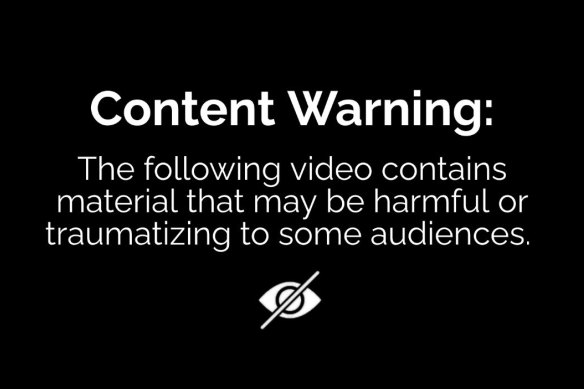By Liam Mannix
Examine, a free weekly newsletter covering science with a sceptical, evidence-based eye, is sent every Tuesday. Below is an excerpt – sign up to get the whole newsletter in your inbox.
In 2017, Monash University rolled out a controversial new pilot program. Warnings would be placed on 15 of the university’s courses letting students know the content – about sexual assault, domestic and child abuse, suicide and animal cruelty – was potentially emotionally distressing.
The trigger warning pilot came after years of campaigning by the university’s student association, the ABC reported. “This will allow students who do have a response, whether that be an anxiety attack or a panic attack based on any previous traumatic experiences, to be able to prepare themselves,” the association’s president Matilda Grey said.
The ABC story went on to canvas the arguments that have been levelled against trigger warnings: that they shelter people from the harsh realities of life, stop them engaging with challenging material and deny free speech.

Scientific research has found trigger warnings are ineffective.
The culture war that has raged over trigger warnings has been as vicious as it has been evidence-free. But the research that is starting to emerge renders the debate largely moot – because here’s what it says: trigger warnings don’t have any effect on a person’s response to content.
“They don’t seem to do anything,” says Flinders University’s Associate Professor Melanie Takarangi, who has published several studies on trigger warnings. “There is really no meaningful difference to how people react to something whether they received a trigger warning or not.”
Trigger warnings originated in the late 1990s on internet message boards; they were first applied to content that graphically depicted rape. Those posting the warnings were worried reading such content might trigger panic attacks or, in people with post-traumatic stress disorder, intrusive memories.
The concept soon expanded and hit the mainstream in the mid-2010s. Students at several American college campuses called on their administrations to add official trigger warnings to potentially harmful material.
Writing in the university’s newspaper, students at Columbia University detailed a friend’s experience: “During the week spent on Ovid’s ”Metamorphoses”, the class was instructed to read the myths of Persephone and Daphne, both of which include vivid depictions of rape and sexual assault. As a survivor of sexual assault, the student described being triggered while reading such detailed accounts of rape throughout the work. However, the student said her professor focused on the beauty of the language and the splendor of the imagery when lecturing on the text.”
Trigger warnings are used more broadly now than just to avoid PTSD triggers. Philosophy lecturer Assistant Professor Kate Manne has written the warnings allow students who are sensitive to certain content to prepare themselves. “Exposing students to triggering material without warning seems more akin to occasionally throwing a spider at an arachnophobe.“

Associate Professor Melanie Takarangi has found trigger warnings make no meaningful difference.
As happens far too often, it was not until trigger warnings were mainstream that we started asking the key question: do they actually achieve their goals?
The best study to date comes out of the University of Waikato in New Zealand. Almost 1400 people participated across six experiments, and researchers conducted a mini meta-analysis of the experiments to extract powerful conclusions.
The subjects read short stories or watched short films, including public service advertisements showing car crashes. The researchers carefully measured their anxiety, negative feelings or intrusive memories. Some were shown trigger warnings beforehand.
Across the six tests, the researchers could find no difference between people who had or had not seen trigger warnings, including in a small group who had experienced prior trauma – arguably the target of such warnings.
Melanie Takarangi’s research adds a layer to this. Remember one of the key roles of trigger warnings is to allow people to prepare to view potentially distressing content. She has shown that people exposed to trigger warnings don’t do anything different. They are just a little more anxious about the content to come.
“When people see trigger warnings, they actually experience anxiety – anticipatory anxiety. It makes them feel uncomfortable,” she says. But the warnings don’t seem to change the way we experience the triggering content itself. “Our data shows they don’t seem to do anything.”
Let’s think about what’s going on here. Trigger warnings alert us about upcoming content, but best-practice warnings don’t just warn, they tell us how to respond. Imagine a bushfire warning that simply said “warning – a bushfire is approaching”. Instead, our emergency warnings tell us what to do: monitor conditions, leave now or shelter in place.
If you encounter a trigger warning, do you have a mental toolkit you can deploy to protect yourself from trauma? I don’t. Trigger warnings tell us something bad may be about to happen but I suspect most people have no idea how to respond.
The simplest response might be to not keep reading. But in experiments, people don’t seem to do that – indeed, the trigger warnings seem to tickle our natural curiosity.
“Lots of people will talk about the importance of having a choice, knowing what the info is they are about to see,” says Takarangi. “But often it seems to be that people will look anyway.”
You might be able to build a better trigger warning – for example, advising people how to respond. But … what’s the evidence there’s a problem here that needs fixing?
Post-traumatic stress disorder develops after exposure to life-threatening trauma, including sexual assault; environmental cues can trigger involuntary “intrusive memories”. An estimated 12 per cent of Australians experience PTSD in their lifetime – so it’s possible there is a problem.
Protecting people with PTSD from unwanted intrusive memories seems like a good and generous thing to do. But psychologists generally think of avoidance as harmful because it interferes with the processing of trauma memories.
And how triggering is, say, a university course or a book or a social media post? How big is the problem and who is affected? If we are worrying about causing harm to people who are sensitive to certain content types, shouldn’t we start by trying to work out how many people are being harmed?
“How do we know being triggered in class is what students are most worried about?” says Takarangi. “There is no data that necessarily says that’s true.”
In trying to do a good deed, have we built warnings that are ineffective and unscientific – and that target a problem we’re not even sure exists?
Enjoyed this article? The Examine newsletter explains and analyses science with a rigorous focus on the evidence. Sign up to get it each week.